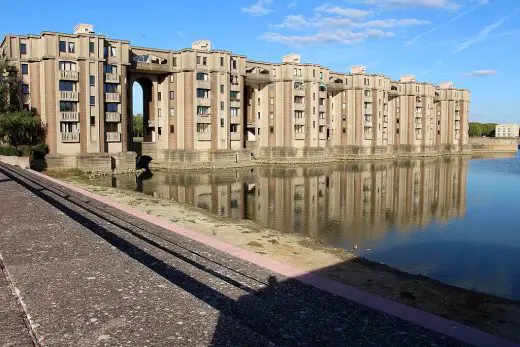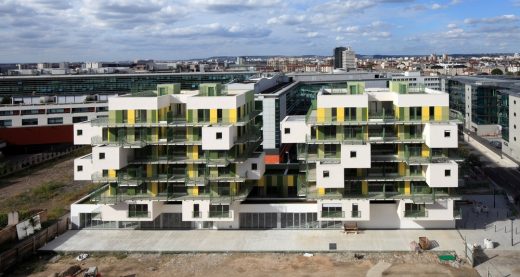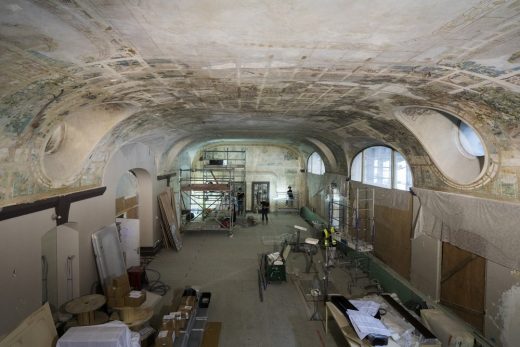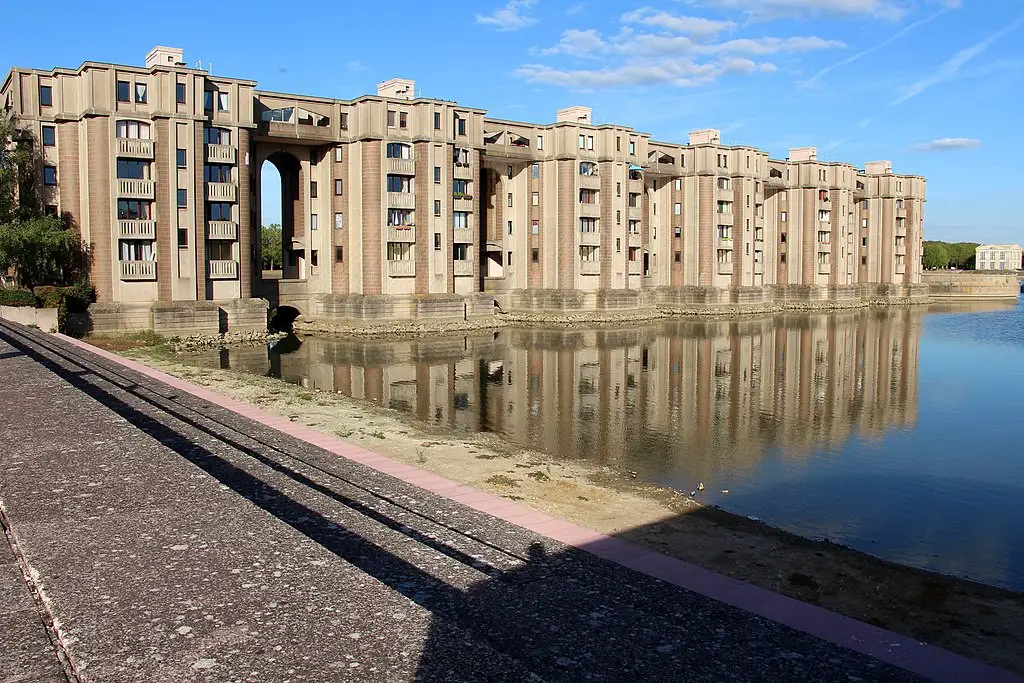Les Arcades du Lac, Saint Quentin-en-Yvelines Building, French Project, Design, Property
Les Arcades du Lac, France : Saint Quentin-en-Yvelines Building
Les Arcades du Lac France – design by Ricardo Bofill : Architecture Information
post updated 14 January 2022
Architect : Ricardo Bofill – ‘Taller de Arquitectura
English text (scroll down for Spanish):
Les Arcades du Lac, Saint Quentin-en-Yvelines, France
Dates built: 1978-82
Les Arcades du Lac, Saint Quentin-en-Yvelines Building
This, the first major project by the Taller de Arquitectura to be built in France, forms part of the villes nouvelles policy which the French government adopted for the outskirts of Paris: whole towns created from scratch in order to ease the congestion in the city centre and promote orderly growth while avoiding as far as possible the creation of mere suburbs. As well as being the first of Bofill’s constructions in France, this scheme constitutes a significant landmark in the history of the Taller de Arquitectura.
Montigny-le-Bretonneux – Rue Jacques Cartier The Postmodernist Arcades du Lac (résidence le Viaduc). The design was inspired by the Pont d’Avignon, Château de Chenonceau and the Aqueduct of Segovia:

photo : Fred Romero from Paris, France, CC BY 2.0 https://creativecommons.org/licenses/by/2.0, via Wikimedia Commons
In the texts of the time which served to introduce the project, the point of departure was established as being the relationship between technology and architectural history, thus defining and seeking to combine avant la lettre the two different tendencies which were subsequently taken up the movement known as postmodernism.
A product of the darkest moment of the crisis of the 70s, this is a project which seeks to resolve the acute housing problem speedily and economically. The form and distribution of the blocks of apartments is based on the elements of a French garden, introducing a considerable change of scale and transforming the hedges into buildings. This layout made it possible to generate the public spaces basic to the formation of the town: the street and the square. The street as the place of circulation, and the square as the place for meetings and get-togethers. Thanks to the large underground car park which links all the blocks together, all of the streets are exclusively pedestrian, some of them flanked by porticoes.
The orthogonal layout of the blocks, streets and squares also evokes a solution adopted on a number of historic occasions, from the Hippodamus of Miletus to New York, by way of La Valette and Ildefons Cerdà’s Barcelona. The simplicity of the orthogonal organization is amply justified by the functional efficiency, all the more so in times of crisis such as the period from which the scheme dates. The compositional analysis of the French garden was not restricted to a reproduction of its forms, but was a genuine attempt at creating a garden city, in which the vegetation and the lake play a fundamental part.
The notable presence of the lake prompted the construction of and the form adopted for new blocks of housing built out over the water in a return to the famous over the water in a return to the famous French tradition of building castles on bridges, especially in the Loire region. The Taller de Arquitectura’s final concern, at the moment of the project’s starting on site, focused on the danger arising from the ease with which the urban model they had evolved could be picked up and copied without a similar recreation of the rigorous analysis which necessarily preceded their scheme. In time, their misgivings were in part confirmed, and the postmodern movement that was then beginning to emerge was discredited by an unthinking vulgarization comparable to that suffered in its time by the Modern Movement.
389 subsidized apartments grouped in four square blocks with a spacious interior courtyard, accessible from the street. The buildings consist of ground floor and three upper floors. The decision to observe a maximum depth of only 8-10 (26′-33′) metres to the apartment blocks means that all the houses have dual orientation. The stairs are located in pavilions which project out from the façade, serving two doors to a landing and giving direct access to the car park.
Les Arcades du Lac – Building Information
program of dwellings and public spaces with plazas and gardens on the shores of an artificial lake.
client: Foyer du fonctionnaire et de la famille
gross area: 31,000 m2
Spanish text:
Les Arcades du Lac, Saint Quentin-en-Yvelines, Francia
1982
El primer gran proyecto del Taller de Arquitectura construido en Francia forma parte de la política de villes nouvelles emprendida por el Gobierno francés para la periferia parisiense, ciudades creadas a partir de cero para descongestionar el dentro de la capital y propiciar un crecimiento ordenado evitando los suburbios en la medida de lo posible. Aparte de ser el inicio de las construcciones de Bofill en Francia, este proyecto marca un hito importante dentro de la historia del Taller de Arquitectura. En los textos de la época que sirvieron de presentación del proyecto, se establece como punto de partida la relación entre tecnología e historia de la arquitectura, definiendo e intentando combinar avant la lettre las dos tendencias differentes que tomaría el moviendo llamado posmoderno.
Realizado en el momento más grave de la crisis de los años setenta, es un proyecto destinado a solucionar el grave problema de la vivienda de forma rápida y con medios muy limitados. La forma y distribución de los bloques de viviendas se basó en los elementos de un jardín francés jugando a un amplio cambio de escala y convirtiendo los setos en construcciones. Esta distribución permitió que se generaran los espacios públicos básicos para la formación de una ciudad: la calle y la plaza. La calle como lugar de circulación y la plaza como lugar de encuentro y reunión. El gran aparcamiento subterráneo que comunica todos los bloques permite que todas las calles sean peatonales, algunas de ellas porticadas.
El trazado ortogonal de las manzanas, calles y plazas ev oca también una solución adoptada históricamente en numerosas ocasiones, desde Hipódamo de Mileto hasta Nueva York, pasando por la La Valette o la Barcelona de Ildefons Cerdà. La simpleza de la organización ortogonal quedaba ampliamente justificada por su buen funcionamiento, especialmente en épocas de fuerte crisis como la que se sufría en aquel momento. El análisis compositivo del jardín francés no se limitó a una reproducción de sus formas, sino que realmente se intentó la creación de una ciudad jardín, donde la vegetación y el lago tienen un papel fundamental.
La fuerte presencia del lago sugiere la construcción y la forma adoptada por unos nuevos bloques de viviendas sobre el agua, retomando la tradición francesa de los castillos-puente, especialmente famosos en la región del Loira. La reflexión final del Taller de Arquitectura en el momento de construcción del proyecto se centró en el peligro que entrañaba la facilidad de divulgación y reproducción del modelo urbano establecido sin que también se reprodujera el riguroso análisis realizado con anterioridad. El tiempo confirmó, en parte, esta previsión pesimista y el movimiento posmoderno que entonces empezaba a manifestarse sufrió el descrédito provocado por una vulgarización irreflexiva paralela a la experimentada anteriormente por el Movimiento Moderno.
389 viviendas sociales agrupadas en cuatro manzanas cuadradas con un amplio patio interior accesible desde la calle. Los edificios disponen de planta baja y tres pisos. La decisión de dar solamente un espesor de 8-10 metros a los bloques de viviendas permite que todos los apartamentos puedan tener doble orientación. Las escaleras están situadas en unos pabellones que sobresalen de las fachadas, sirviendo a dos puertas por rellano y permitiendo el acceso directo al aparcamiento.
Les Arcades du Lac – Building Information
programa de viviendas y espacios públicos con plazas y jardines a orillas de un lago artificial.
cliente: foyer du fonctionnaire et de la famille
superficie: 31.000 m2
Les Arcades du Lac image / information from Ricardo Bofill
Les Arcades du Lac design : Ricardo Bofill
Location: Arcades du Lac, Saint Quentin-en-Yvelines, France
New Buildings in France
French Architectural Projects
French Architectural Design – chronological list
French Architect Offices – design firm listings
Paris Architecture Walking Tours by e-architect
French Architecture – Selection
28 Social Housing Units, Courbevoie, Paris, France
Architects: Koz architectes

photography © Guillaume Grasset and Jean-Baptiste Pellerin
28 Social Housing Units in Courbevoie
Hôtel Lutetia, 45 Boulevard Raspail, Saint-Germain-des-Prés, 6th arrondissement
Renewal Design: Jean-Michel Wilmotte Architects

photograph courtesy of architects office
Hôtel Lutetia
Les Arcades du Lac design : Ricardo Bofill architect
Comments / photos for the Les Arcades du Lac French Architecture page welcome

